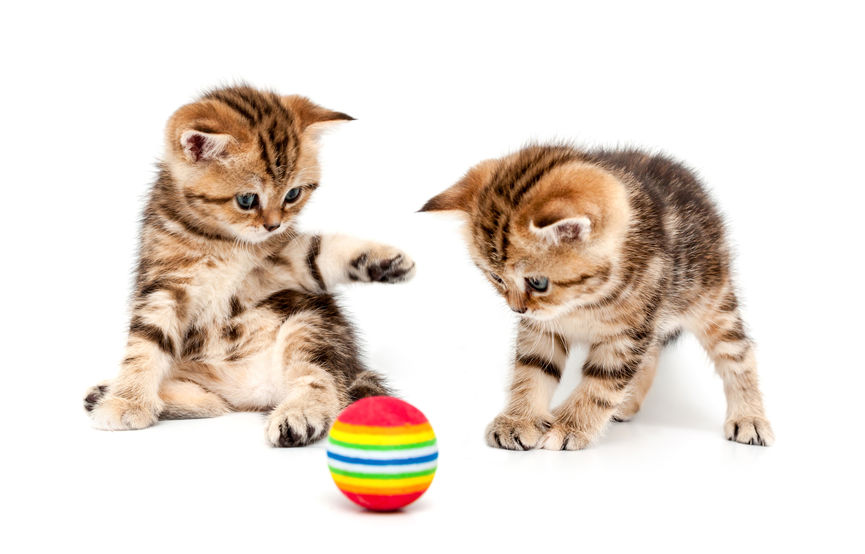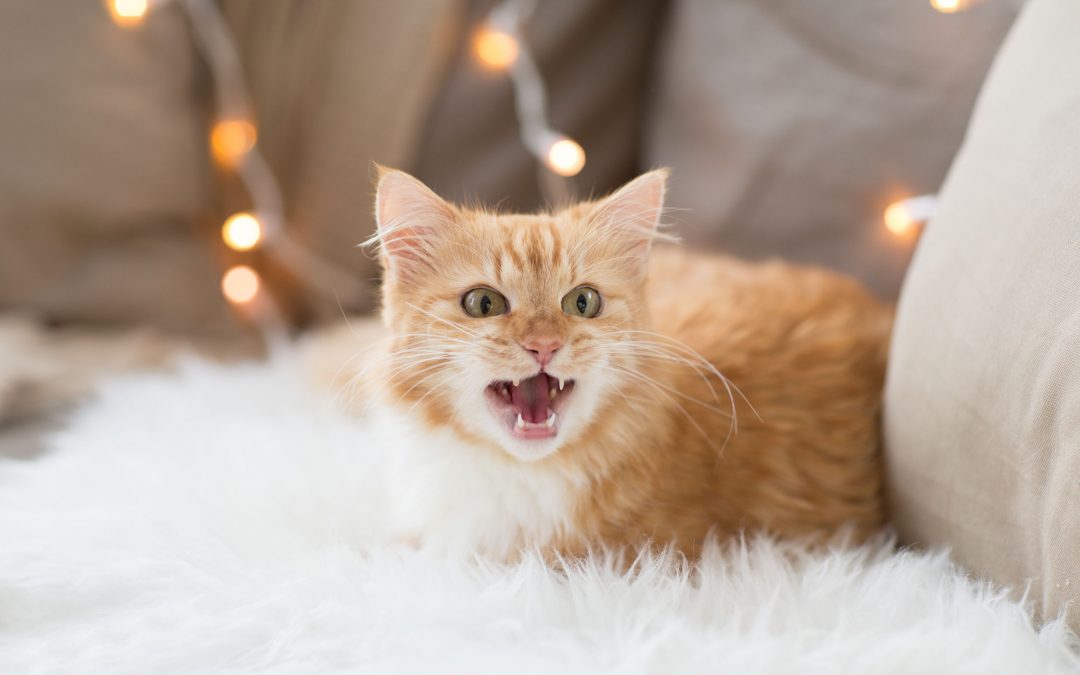There are so many fun things to do with your cat to help them stay physically and mentally fit. Playtime can provide exercise, bonding time, mental stimulation, and more. Continue reading for some fun ideas that are sure to keep feline boredom at bay.
Pet Play Time: Cat Toys, Scratching Posts, Laser Pointers, And More
Adequate playtime for your kitty can have a double-barreled effect. Your cat needs exercise, but your cat also needs playtime to keep their brain active.
Let’s face it, most domestic cats live a pretty luxurious existence in this era. They have cozy cat beds (possibly your bed) and they have no need to hunt for food. Many are kept indoors as house cats, and fed each day without having to chase potential prey. For some cats, this could mean they aren’t getting the mental and physical stimulation they need.
So, what are some fun things to do with your cat? Here are some great games. And, remember, you can teach an older cat new tricks.
Cat Toys
Cat toys are much more than furry toy mice or squeaky rubber squirrels. As it turns out, there are some great interactive toy options available for playtime.
 Food puzzles are a common favorite toy among cat parents. These are basically “reward toys” that provide your cat with positive reinforcement for being “smart.”
Food puzzles are a common favorite toy among cat parents. These are basically “reward toys” that provide your cat with positive reinforcement for being “smart.”
The idea is that they force your pet to use their brain before they can receive a food reward.
This type of toy may also help their natural hunting instinct to kick in.1
You can buy a great range of food puzzles, or you can DIY one. Your cat will have to work out how to get to the treats, and it should keep them occupied for some time.
If you’d like to make your own food puzzle, you can use a paper towel roll and simply cut holes in the side. Fill the roll with treats and tie off the ends. Your cat will battle that tube until it finds a way for those treats to topple out.
Scratching Posts
Scratching posts may keep your cat from scratching up your furniture. As it turns out, they may also provide an opportunity to keep your cat occupied with some physical stimulation. Cats love to scratch for many reasons: to stretch their bodies, to polish their claws, after using their litter box (to get cat litter off their paws), or just to have some fun.
Many scratching posts also double as multi-story play gyms. The height and levels allow your kitty to jump, climb, sit, and hide out in the commonly-attached furry cubby holes.
You might also like to hang some rope down the length of the post, so your cat can hang on it and stretch.
Finally, cats like to scratch in both vertical and horizontal directions, so take this into consideration as well.2
If you’re creating a DIY cat scratching post, you can wrap sisal rope around the sides of a post for vertical scratching action, while cardboard scratching mats can offer horizontal scratching.
You can even add some cat grass for your cat to nibble on while they’re hanging out.
Laser Pointers And Feather Wands
 There’s no denying that cats love things that move. Movement stimulates a kitty’s hunting instinct. Suddenly, your cat kicks into high gear – they’re alert and ready to pounce.
There’s no denying that cats love things that move. Movement stimulates a kitty’s hunting instinct. Suddenly, your cat kicks into high gear – they’re alert and ready to pounce.
Laser pointers are a favorite of many cat owners, as they often make cats crazy with joy.
These pointers provide your cat with a great physical workout as they try to “catch” that red dot.
Two things to note when it comes to laser tricks:
First, laser pointers are safe, but don’t shine them directly into your cat’s eye. If it happens by accident, there’s no need for alarm.
Second, though most cats will settle down after some laser play, some cats do get agitated by the fact that they can never “win” with the laser.3
So, it can be good to finish playtime with a game that your cat can win – something that can be caught and conquered. Wrap up a good play session with toys like feather wands or a stuffed toy mouse.
Hiding
Animals and kids alike love to play hide and seek. There’s a challenge involved, and you cat will view this as a hunting mission. You can play hide and seek in two ways.
 1. Consider hiding your cat’s food in different places around the home. Don’t make it so difficult that they can’t find it, but keep it a little challenging.
1. Consider hiding your cat’s food in different places around the home. Don’t make it so difficult that they can’t find it, but keep it a little challenging.
2. Play the usual game as if you were playing with a small child. Call out to them regularly so they can hear your voice and know you’re still here. Start with just a few minutes at a time. Keep trying this in small spurts, with lots of vocal communication until they get the hang of it.
When you “find” each other, make a big deal out of it, so your cat feels rewarded.
Cats also enjoy small, comforting hiding places – like boxes. So let them hide in a box and then act surprised when they emerge.
Walks Aren’t Just For Dogs: Train Your Cat To Walk With A Collar And Leash
Spend some time with your furry friend in the great outdoors by taking them outside on a leash. It may not be as common a sight as a dog on a leash but leashed cats are definitely becoming more popular.
So, how do you convince a fickle feline to allow you to walk them on a leash? It takes time, patience, and positive reinforcement.

- For dogs and cats alike, positive reinforcement almost always means food. Start by associating the harness with food – leave it by their food bowl, or let them sniff it and reward them with food.
- When you first try the harness on your cat, do it at mealtime while they’re distracted by food. Don’t fasten the harness the first few times. Leave it on loosely for a few minutes, and then provide more treats. Do this for several days. Slow and steady is key.
- Your cat has probably never experienced something on their back, so it’s going to take some time to adjust to it. Perhaps weeks.
- The first time you attach the leash, do it inside and let it either drag along behind your cat (if your cat likes that) or hold it very loosely. Provide plenty of cat treats and petting while the leash is attached.
- Once you’ve had some practice, it’s time to try applying a little pressure on the leash and calling your cat to you. When they come, reward them with a treat.
- When you finally venture outside, keep in mind that the great outdoors is highly stimulating to the senses, especially if you have a house cat. You should start in your own backyard and work your way up and out in very small increments.
- Finally, understand that not all cats are good candidates for this kind of cat exercise. Ideally, start with leash walks when your cat is a kitten. Things can get more challenging with an adult cat. Ultimately, if leash walks aren’t working out, don’t force it.4
Inactivity Might Not Be Simple Boredom: Know When To See Your Cat’s Veterinarian
If you have an unusually lethargic cat, it’s time to talk with your veterinarian. Yes, cats are a little lazy by nature. If they’re overfed or under-exercised – even more so. However, an unnatural amount of lethargy could be a sign of illness.
Some illnesses that may cause inactivity in cats include:
- Parasitic infections
- Stress
- Arthritis
- Cat flu infections
- Diabetes
- Viral infections
- Anemia
- Urinary tract infections
- Heart disease
- Respiratory problems
- Gastrointestinal disorders
- Poisoning5
A Healthy Diet For Long (Nine) Lives
While plenty of activity and stimulation is essential for a healthy, happy cat, so is a nutritious diet. Always make sure your cat is eating a healthy, balanced diet in order to be their most active self. Dry cat food alone just doesn’t cut it. If you’re unsure whether your cat is eating the right diet, check with your vet.6
What can cats eat? There are some human foods your cats can have in moderation
Learn More:
A List Of The Most Playful And Friendly Cat Breeds
A List Of The 10 Most Energetic Dog Breeds
Changes In Environment For Cat Enrichment
Sources
1.https://blogs.scientificamerican.com/not-bad-science/how-to-enrich-cats-lives-food-puzzles-for-cats
2.https://www.companionanimalpsychology.com/2017/03/what-kind-of-scratching-post-do-cats.html
3.http://www.vetstreet.com/dr-marty-becker/are-laser-pointer-toys-really-safe-for-my-cat
4.https://www.adventurecats.org/backcountry-basics/train-your-cat-to-walk-on-a-leash/
5.https://wagwalking.com/cat/condition/lethargy
6.http://www.treehouseanimals.org/site/PageServer?pagename=caring_health_veterinary_feline_nutrition































